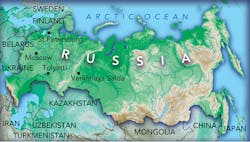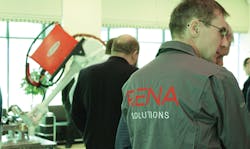Status of the industrial laser market in Russia
The Russian laser market has historically deep traditions because of the high level of laser engineering education in the USSR—the first laser prototype was built there in 1955. Soviet scientists Nicolay Basov and Aleksandr Prokhorov won the Nobel Prize in Physics in 1964 “for the fundamental work in the field of quantum electronics, which has led to construction of oscillators and amplifiers based on the maser-laser principle.”
A substantial academic base had very limited industrial applications and there was no scaling of laser technology. The technology was first applied in Moscow in 1968 for eye surgery and by 1973, more than 200 devices were built. Soviet industry started using laser cutting in the 1980s, but wide application of the technology ceased because of the political situation.
The economy of the new Commonwealth of Independent States (CIS) in the 1990s shrank rapidly because of the collapse of industrial cooperation and economic relations. The only positive point about this was that the former Soviet people could start their own businesses, but in terms of the economic situation in general, this factor played an insignificant role.
Many Russian engineers and scientists left the country in the 1990s, obtaining jobs in various European and U.S. companies. Only a few of those who left started their own business. The most successful company—IPG Photonics (Oxford, MA)—was established by Russian scientist Valentin Gapontsev. The company changed the market of laser sources by spreading fiber lasers for various applications. Many other companies like LIMO (Dortmund, Germany), Hypertech Laser Systems (Lübeck, Germany), and O.R. Lasertechnology (Elk Grove Village, IL) have Russian scientific and engineering backgrounds. Hypertech Laser Systems occupies a leading position in skin cosmetology worldwide and is involved in Russian-German cooperation.
Industrial laser market conditions
In the 1990s, the manufacturing industry of the new CIS countries shrank and only started to grow again after 1998. Oil prices started to feed the Russian budget and the Government supported the industry by beginning a transportation system renewal. Locomotive and railroad car manufacturers began to apply laser cutting machines and industrial laser technologies that were widely used in other industries.
Because of market growth and the absence of any significant local manufacturers of laser cutting machines, companies like TRUMPF (Ditzingen, Germany), Bystronic (Niederönz, Switzerland), Amada (Kanagawa, Japan), and Prima Power (Turin, Italy) came to Russia in the 2000s, while IPG Photonics established production facilities in Russia and became a leading supplier of fiber lasers for laser cutting and other applications. Among the trends of the 2000s was localization of laser machine production and integration of lasers.
As a result, the Russian laser market reached $100 million in 2008, with laser cutting machines as the largest share. TRUMPF remains the leading supplier of laser cutting machines—many Russian customers choose TRUMPF because of this company’s broad experience and the reliable after-sale service, offering spare-parts stock at local warehouses. Russia renewed its manufacturing industry and started to grow a share of laser cutting services by building production shops containing from five to 15 laser cutting machines, accompanied by bending, welding, painting, and other equipment.
Next-generation advanced driver assistance systems (ADAS) and autonomous vehicles required light detection and ranging (lidar) for detecting objects in combination with cameras involves inventors in technological start-ups. National automotive manufacturers cooperate with universities for development of solutions for new ADAS with lidar.
After the deep recession in 2009, the market managed to restore by 2011 and remained at the same level until the ruble devaluation at the end of 2014. Recovery started in 2015 with the recovery of the agricultural machine industry and this trend was adopted by the local automotive industry. Some Chinese laser companies began trying to gain a share of the existing market for laser cutting machines and laser sources by offering attractive prices and spare parts/service strategies. Several Chinese laser cutting machine producers gained market share that had not been available before because of very high leasing and credit rates. This market share brought some capacity and, of course, created new possibilities for business.
Addressing implementation challenges
One of the fundamental problems of wider implementation of laser cutting is the absence of services in sheet layout design, generating added value for business. Russian industrial design needs improvement for applying such high-end technologies as laser welding. It is very important to form a market segment that will apply laser cutting, bending, and laser welding for manufacturing of high-tech products. Only a few companies, such as NPP RUSMET (Lyuburtsy, Russia; www.npprusmet.ru), have strong competence in designing and manufacturing in cutting and welding.
The Russian Government has developed an industrial development program to support the manufacturing industry with new engineers and CAD/CAM products, but private companies are shown weak response and they need time to form a sheet layout design culture. Some companies invite engineers from Europe, mainly Germany, that are experienced in design. What we have here is a typical Russian paradox: the first laser was developed in this country more than 50 years ago, but now there are engineers in demand to utilize industrial application of laser technologies.
Russia’s automotive market is growing, and several automotive manufacturers located their production facilities in Russia in 2000 and 2010: VW, Renault-Nissan, and Toyota. Tier 1 suppliers have some advantages because of the stability of ruble pricing—the automotive market shows 17% growth in 2017 and the forecast for 2018 is the same. Demand by the automotive industry for laser sources for welding, brazing, and marking grows from year to year. Russian industrial automation integrators attained positive experience during the previous 10 years and expects to gain share of the new markets in the U.S., China, and Europe.
Titanium company VSMPO-AVISMA (Verkhnaya Salda, Russia) participates in a worldwide cooperation with aircraft manufacturers by launching a Titanium Valley open economic area with new technologies to create a synergy in the aerospace and medical industry. Titanium components made using selective laser melting (SLM) or direct metal deposition (DMD) technology have huge market potential. Cooperation with industry leaders can become a point of growth in the near future and result in titanium with “Made in Russia” identification. Some steps towards this goal have already been taken by the local medical component producers. Several conferences have been held where implementation of technologies was discussed and several Russian medical universities are running trials during treatment processes. All that is required are changes to regulations and approval of technologies.
The Russian manufacturing industry contains a huge number of applications for lasers, such as cladding, coating, composites welding, and other different types of treatments, which can create many jobs. The era of electric cars opens wide perspectives for application of lasers. There is a demand for wider application of lasers for copper welding, and there are some interesting applications for green lasers with higher absorption and new processing factors forcing new technological research and development (R&D). There is the prospective laser application for welding battery cases and for cutting coated electrical steel for motors. These fields of activity attract laser R&D teams to compete for government grants founded to support new products development.
The company Laserline (Mülheim-Kärlich, Germany) is engaged in the development and production of high-power diode lasers for materials processing in applications in the automotive, aerospace, general manufacturing, and oil and gas industries, among others. The company is engaged in aluminum welding for car bodies, carbon fiber 3D printing, and titanium additive manufacturing, as well as other applications. Despite the high entry barriers that now exist for foreign companies in Russia, the company has managed to successfully maintain and grow the business with existing and new partners in the region.
Technology demonstration
On March 17, 2018, in the town of Togliatti—the heart of Russian automotive industry—a conference was held dedicated to integration of diode lasers in automotive and general manufacturing industries such as electric components production, with representatives from Laserline, ABB Robotics (Zurich, Switzerland), and Rena Solutions (Tolyatti, Russia). Participants came from all parts of Russia and speakers made interesting presentations regarding remarkable cases.Evgeny Molchanov
Evgeny Molchanov is the Commercial Director for Rena Solutions in Bolshaya Serpukhovskaya, Russia, and is a correspondent on industrial laser activity in Russia for Industrial Laser Solutions.


